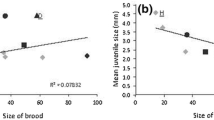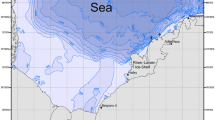Abstract
Two morphs of the asteroid genus Echinaster, E. Type 1 and E. Type 2, have reciprocal annual cycles of reproduction and nutrient storage. The pyloric caeca (storage organs) reach maximal size over winter then decrease with increasing gametogenic activity in the spring. E. Type 1 broadcasts buoyant eggs in late May to early June. E. Type 2 deposits benthic eggs in late April. Lecithotrophic larval development is similar in both morphs except that larvae of E. Type 1 undergo a brief planktonic phase. E. Type 1 reaches sexual maturity at a larger size, expends a lower reproductive effort but has a greater absolute reproductive output than E. Type 2. E. Type 2 produces fewer, larger eggs and has a greater parental investment per egg. In both morphs, females have much higher gonadal lipid levels than males and expend a higher reproductive effort in terms organic matter and energy. Reproductive effort, reproductive output, nutrient storage in the pyloric caeca and body size varied between populations and between years in each morph. Egg size and parental investment per egg were constant. Within-morph variability is attributed to differences in nutritional state. Differences in reproductive strategy support the hypothesis that the morphs are separate species.
Similar content being viewed by others
Literature Cited
Atwood, D.: Larval development in the asteroid Echinaster echinophorus. Biol. Bull. mar. biol. Lab., Woods Hole 144, 1–11 (1973)
Brody, S.: Bioenergetics and growth, 1023 pp. New York: Reinhold 1945
Campbell, D. B. and R. L. Turner: Comparative skeletal and ossicle morphology of sibling species of Echinaster (Echinodermata: Asteroidea) from the West Coast of Florida. Am. Zool. 19, 1009 (1979)
Chia, F. S.: Classification and adaptive significance of development patterns in marine invertebrates. Thalassia Jugosl. 10, 121–130 (1974)
Cognetti, G. and R. Delavault: Recherches sur la sexualité d'Echinaster sepositus (Echinoderme, Asteride). Etude des glandes genitales chez les animaux des côtes de Livourne. Cah. Biol. Mar. 1, 421–432 (1960)
Crump, R. G.: Annual reproductive cycles in three geographically separated populations of Patieriella regularis (Verrill), a common New Zealand asteroid. J. exp. mar. Biol. Ecol. 7, 137–162 (1971)
Downey, M. E.: Starfishes from the Caribbean and Gulf of Mexico. Smithson. Contr. Zool. 126, 1–158 (1973)
Dubois, M., K. A. Gilles, J. K. Hamilton, P. A. Rebers and S. Smith: Colorimetric method for determination of sugars and related substances. Anal. Chem. 28, 350–356 (1956)
Farmanfarmaian, A., A. C. Giese, R. A. Boolootian and J. Bennett: Annual reproductive cycles in four species of West Coast starfishes. J. exp. Zool. 138, 355–367 (1958)
Ferguson, J. C.: Feeding activity of Echinaster and its induction with dissolved nutrients. Biol. Bull. mar. biol. Lab., Woods Hole 136, 374–384 (1969)
Ferguson, J. C.: Growth and reproduction of Echinaster echinophorus. Florida Sci. 37, 57–60 (1974)
Ferguson, J. C.: The role of free amino acids in nitrogen storage during the annual cycle of starfish. Comp. Biochem. Physiol. 51A, 341–350 (1975a)
Ferguson, J. C.: Fatty acid and carbohydrate storage in the annual reproductive cycle of Echinaster. Comp. Biochem. Physiol. 52A, 585–590 (1975b)
Ferguson, J. C.: The annual cycle of fatty acid composition in a starfish. Comp. Biochem. Physiol. 54B, 249–252 (1976)
Freeman, N. K., F. T. Lindgren, Y. C. Ng and A. V. Nichols: Serum lipid analysis by chromatography and infrared spectrophotometry. J. Biol. Chem. 227, 449–464 (1956)
Giese, A. C.: On the biochemical composition of some echinoderms. In: Physiology of Echinodermata, pp 757–796. Ed. by R. A. Boolootian. New York: John Wiley and Sons 1966
Jangoux, M. and E. Van Impe: The annual pyloric caeca cycle of Asterias rubens L. (Echinodermata: Asteroidea). J. exp. mar. Biol. Ecol. 30, 165–184 (1977)
Jangoux, M. and M. Vloebergh: Contribution à l'étude du cycle annuel de reproduction d'une population d'Asterias rubens (Echinodermata: Asteroidea) du littorial Belge. Neth. J. Sea Res 6, 389–408 (1973)
Kempf, M.: On the development of Echinaster echinophorus (Lmk). Academia Brasileira da Ciencias, Annaes 38, 505–507 (1966)
Lawrence, J. M.: Level, content, and caloric equivalents of the lipid, carbohydrate, and protein in the body components of Luidia clathrata (Echinodermata: Asteroidea: Platyasterida) in Tampa Bay. J. exp. mar. Biol. Ecol. 11, 263–274 (1973)
Lawrence, J. M. and J. E. M. Lane: The utilization of nutrients by post-metamorphic echinoderms. In: Echinoderm nutrition. Ed. by M. Jangoux and J. M. Lawrence. Rotterdam: A. A. Balkema (In press)
Lawson-Kerr, C. and D. T. Anderson: Reproduction, spawning and development of the starfish Patieriella exigua (Lamarck) (Asteroidea: Asterinidae) and some comparisons with P. calcar (Lamarck). Aust. J. mar. freshwat. Res. 29, 45–53 (1978)
Mauzey, K.: Feeding behavior and reproductive cycles in Pisaster ocharaceus. Biol. Bull. mar. biol. Lab., Woods Hole 131, 127–144 (1966)
Menge, B. A.: Brood or broadcast? The adaptive significance of different reproductive strategies in the two intertidal sea stars Leptasterias hexactis and Pisaster ochraceus. Mar. Biol. 31, 87–100 (1975)
Mileikovsky, S. A.: Types of larval development in marine bottom invertebrates, their distribution and ecological significance: a re-evaluation. Mar. Biol. 10, 193–213 (1971)
Oudejans, R. C. H. M., I. van der Sluis and R. J. van der Plas: Changes in the biochemical composition of the pyloric caeca of female seastars, Asterias rubens, during their annual reproductive cycle. Mar. Biol. 53, 231–238 (1979)
Paine, R. T.: The measurement and application of the calorie to ecological problems. Ann. Rev. Ecol. Sys. 2, 145–164 (1971)
Pearse, J. S.: Reproductive periodicities in several contrasting populations of Odonaster validus Koehler, a common Antartic asteroid. Biology of the Antartic Seas II. Antartic Res. Ser. Washington. 5, 39–85 (1965)
Scheibling, R. E.: The annual reproductive cycle of Oreaster reticulatus (L.) (Echinodermata: Asteroidea) and interpopulation differences in reproductive capacity. J. exp. Mar. Biol. Ecol. 54, 39–54 (1981)
Scheibling, R. E.: Differences in body size and growth rate between morphs of Echinaster (Echinodermata: Asteroidea) from the eastern Gulf of Mexico. In: Proceedings of the International Echinoderms Conference — Tampa Bay. Ed. by J. M. Lawrence. Rotterdam: A. A. Balkema (In press)
Stearns, S. C.: Life-history tactics: a review of the idea. Q. Rev. Biol. 51, 3–47 (1976)
Tinkel, D. W. and N. F. Hadley: Lizard reproductive effort: caloric estimates and comments on its evolution. Ecology 56, 427–434 (1975)
Turner, R. L.: Sexual difference in latent period of spawnin following injection of the hormone 1-methyladenine in Echniaster (Echinodermata: Asteroidea). Gen. Comp. Endocrinol. 28, 109–112 (1976)
Turner, R. L. and D. B. Campbell: A redescription of Echinaster modestus Perrier, 1881 (Asteroidea: Spinulosida) from the eastern Gulf of Mexico and the West Indies. Proc. Biol. Soc. Wash. 94, 344–351 (1981)
Turner, R. L. and J. M. Lawrence: Volume and composition of echinoderm eggs: implications for the use of egg size in lifehistory models. In: Reproductive ecology of marine invertebrates, Vol. 9, pp 25–40. Ed. by S. E. Stancyk. Columbia: Univ. S. Carolina Press 1979
Tuttle, R. D.: Allozymic and systematic analyses of three cooccurring froms of the starfish genus Othilia (=Echinaster). Masters thesis, 57 pp. University of Alabama 1979
Tuttle, R. D. and R. Lindahl: Genetic variability in 3 co-occurring forms of the starfish genus Othilia (=Echinaster). Experientia 36, 923–925 (1980)
Vance, R. R.: On reproductive strategies in marine benthic invertebrates. Am. Nat. 107, 339–352 (1973)
Watts, S. A., R. E. Scheibling, A. G. Marsh and J. B. McClintock: Effects of temperature and salinity on larval development of two Echinaster (Echinodermata: Asteroidea) morphs and their hybrids. Am. Zool. 21, 988 (1981)
Author information
Authors and Affiliations
Additional information
Communicated by J. M. Lawrence, Tampa
Rights and permissions
About this article
Cite this article
Scheibling, R.E., Lawrence, J.M. Differences in reproductive strategies of morphs of the genus Echinaster (Echinodermata: Asteroidea) from the Eastern Gulf of Mexico. Mar. Biol. 70, 51–62 (1982). https://doi.org/10.1007/BF00397296
Accepted:
Issue Date:
DOI: https://doi.org/10.1007/BF00397296




